
Here and Beyond
10:00am - 6:00pm,October 28 - December 10, 2017 / Admission Free
[wp-blogro11 catname=air2017-5en orderby=ur1]
ANG Sookoon
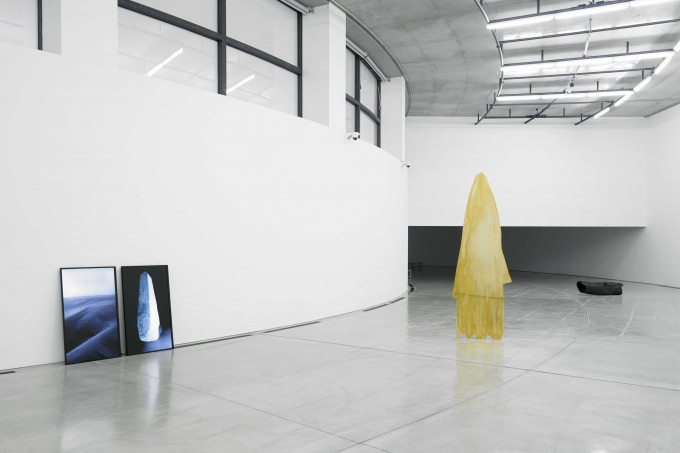
photo: YAMAMOTO Tadasu
From the Blind Spot of Perception
MURAKAMI Aya
“You shouldn’t make something completely beautiful,” ANG Sookoon would often say during production. She said it while making her studies in the studio, and she talked about it while polishing a shining artwork that would put the finishing touches on her installation.
Certainly, we have gotten used to seeing beautiful things. The high-definition images of today communicate to us with intensity, but with the slickness of the screen we lose a certain texture and forget about the space between us and the objects we see. Images are so smooth and elusive that they soon slip out of our consciousness unnoticed. Instead we tend to notice things that change our perceptions through a gritty sense of uneasiness.
No Future No Past is a work comprised of two LCD screens. The displays are placed side by side in portrait orientation, with separate images displayed on each. The image on the left looks like the undulating surface of the sea, while the image on the right is of a big stone or a pillar in ruins. From the grainy look of the video, it is difficult to infer when the video was taken, but it looks like an image from long ago or a scene out of a science fiction movie. Each image repeats, and as you watch, you lose track of time and gain a sense of comfort, one akin to enjoying a natural landscape.
In actuality, the apparent sea is actually an undulating plastic sheet, the image on the left a small clay sculpture that has been magnified. Fellow resident artist Yukari MOTOYAMA had left the plastic sheet on the floor of the ACAC’s studio, which Ang captured as she watched the sheet rise and fall in the breeze of the air conditioner.
Ang is able to seize upon such trivial events and imbue them with a slight sense of discomfort to create her artworks. The screen on which the sculpture is displayed seems to be static but will sometimes flicker, its color and lighting changing ever so slightly. The change is slight enough to make you feel as if the flicker was just you blinking yet strange enough to make you pause for a moment.
Spectre is a work of free-standing, hollowed-out brass panels. At two meters in height, the towering shape is reminiscent of a monster or ghost, and its shining golden appearance feels mystical, like a god or an angel. White traces on the surface enhance the piece’s three-dimensional effect, and its gentle shape recalls the form of both a bedsheet ghost and the draping cloth worn by the Virgin Mary. However, the shape is, in fact, that of a hanging bathrobe.
The shape of draped fabrics, together with the sheen and texture of brass, evokes common imagery of angels or demons. Ang points out just how much we subconsciously rely on memory for perception without observing what actually lies right in front of us.
No Future No Past and Spectre are related to Ang’s past works (*1) (*2), but her third piece, titled Moonlight, shows another side of her creative process. Formed from negative imprints of trees around the ACAC, Moonlight appears, at first glance, to be a black mass about as thick as a pair of legs. But up close, the viewer notices its rough surface and inner cavity and begins to see Moonlight as an old tree lying in decay. The viewer is drawn inside by a pale light that pours through several holes in its surface. Its distorted exterior bears the sadness of old age, yet inside a black sheen hints at an inner life force. Similar to how the viewer’s gaze moves from the outer to the inner surface of the artwork, its ambiguous composition of boundaries between exterior and interior seem to symbolize the ambiguity of life and death. These images seem contradictory, yet, at the same time, the work exists as a single material object, which is strangely attractive. Ominous yet beautiful, Moonlight draws the viewer in.
While we may occasionally appreciate plant life indoors or be touched by the beautiful greenery of a lush forest, we hardly give second thought a rotting piece of wood. Its existence has been forgotten and reduced to a hollow shell of thick bark. The wood lies reticent on its side, a blackened sculpture for all to see and ponder. Moonlight’s shining black surface shows us a figure full of life and shakes our perceptions of the boundaries between life and death as if to shatter our usual dismissal of such trivial things.
Ang’s works are full of questions for interpreting existence. She adds a little bit of uneasiness to commonplace images of things that would otherwise go unnoticed, pointing out how age-old filters influence our interpretations of the world. Just as literature can show us new worlds by arranging familiar words in unexpected ways, so too can a slight uneasiness cause us to question our usual perceptions.
(translate: Queen & Co. )
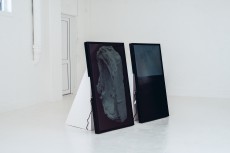
fig.1
4PM
video installation, LCD Screens, 2016.
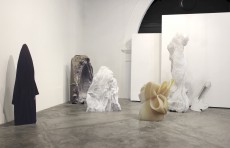
Fig.2
PRESENT TENSE series
Cutout standee installation, Inkjet print on aluminum, exhibition at Objectifs Centre, 2016.
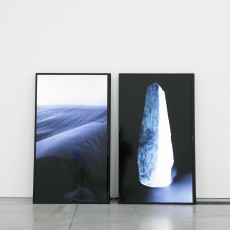
No Future No Past
Diptych video installation, 2017.
photo: YAMAMOTO Tadasu

Spectre
Brass, 2500×860×600 mm, 2017.
photo: YAMAMOTO Tadasu

Moonlight
Clay, approx. 1350×350×350mm, 2017.
photo: YAMAMOTO Tadasu
この現実のむこうに―Here and Beyond
10月28日(土)-12月10日(日)10:00-18:00 会期中無休/無料
アン・スークーン
ANG Sookoon

撮影:山本糾
認識の死角から
村上 綾
「完全に美しくしてはダメだ」と、アンは制作中にたびたび話していた。スタジオで試作を繰り返していたときも、ギャラリーでの設営の最後の仕上げのときも輝く作品の表面にポリッシュをこすりつけながら、そう話した。
確かに、私たちは美しいものを見慣れてしまった。現在の高画質な映像は私たちに迫力を持って伝えるけれども、きめ細やかなその画面は、質感を奪い、私たちと物との間にあるはずの空気を忘れさせる。なめらかすぎて、つかみどころがなく、いつの間にか意識からすべり抜けてしまう。今や私たちが意識するのは、ざらりとした違和感をもって認識を変えるものではないだろうか。
《No Future No Past》は2つのディスプレイからなる作品である。モニターは縦長の状態で置かれ、それぞれに異なる映像が流された。向かって左側の映像は海や水面が波打つような、右側は大きな石や遺跡の柱のようなものの映像である。荒い画質からは時代が推測できず、ひどく昔の映像にも、SF映画での風景にも見える。それぞれの映像は繰り返され、眺めていると時間を忘れて大自然を見るような心地よさを覚える。
しかし実は、左の映像はビニールが揺れているところ、右は粘土で作った小さな彫刻を拡大して映したものである。ビニールシートは、本山ゆかりが制作していた部屋の床に敷かれており、それが空調の風で揺れているのを見かけて撮影したものだった。
アンはそのような非常に些細な出来事を拾い上げては、少しの違和感を加えて作品をつくる。映し出されている彫刻は静止しているように見えるが、ときどき画面がちらつき、色や光の調子が変化する。その変化は、自分のまばたきのせいかと思うほど些細だが、私たちの足を止めるのに十分なほど奇妙である。
《幻》は、真鍮のパネルを切り抜き、自立させたものである。2mほどだろうか、大きくそそり立つ形は怪物や幽霊を思わせ、金色に輝く姿は神や天使のような神秘性も感じさせる。表面に付いた白い跡は立体感を高め、ゆるやかな形は、幽霊が身に着ける布と同時に、聖母のまとう布のドレープを想起させる。だが、実のところ、それはバスローブをぶら下げた形である。ただ布が垂れ下がったありふれた形を、真鍮の質感や輝きから、私たちは今まで見てきたイメージを参照して、天使や悪魔を表していると想像してしまう。それは、いかに私たちが目の前のものを観察せず、無意識に記憶に頼って認識しているかを指摘するのである。
《No Future No Past》と《幻》は、これまでの彼女の過去作[fig.1][fig.2]と関連をもつが、3つ目の作品《月あかり》は、ACAC周辺の木を象ったもので、先に挙げた2つの作品とは異なった趣を見せる。一見すると人の両脚くらいの大きさの黒い塊だが、近づいてみると空洞であることや、ごつごつした表面に気づき、老木が朽ちて横たわっている様子であることがわかる。ところどころにある隙間から差し込む光に誘われて、私たちの視線は内側に向かう。いびつな外側は老いを思わせ、哀愁をまとっているが、一方で内側の黒い艶は、その生命力をほのめかすようである。外側をなぞっていた視線が、ほどなく内側に到達するように、内と外の境目が不明瞭な構造は、生と死の曖昧さを象徴するようだ。矛盾する印象を与えるとともに、一つの物体として成立する様子は、魅力的な違和感を与え、まがまがしくも美しく人の目を引くのである。
私たちは、ときに室内でさえ植物を愛でるけれども、森林の中を歩くとき、美しい緑に心を奪われはしても、老い朽ちた木に一瞥も与えない。そのように存在も忘れられ、分厚い皮だけの存在となった木は、黒一色の彫刻となり静かに横たわると、人々はなでるように見つめ、思索を重ねる。《月あかり》の黒光りする表面は、普段の私たちの無関心を見返すように、生き生きとした様を見せつけ、生と死に境界があるという私たちの認識を揺るがすのである。
アンの作品は、存在をとらえることへの問いに満ちている。私たちが普段は気にも留めない存在のイメージに少し手を加えることで、違和感を発生させ、私たちの見え方には使い古されたフィルターが存在することを指摘していく。文学が、ありふれた言葉の思いがけない組み合わせによって私たちに新しい世界を気づかせるように、見慣れたものに違和感を加えることで、私たちの認識を問いただすのである。
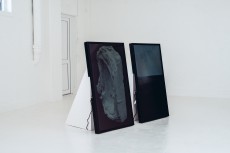
fig.1
《4PM》
ビデオインスタレーション、液晶ディスプレイ、2016年

fig.2
《現在時制シリーズ》
インスタレーション、アルミニウムにインクジェットプリント、Objectifs (シンガポール)での展示、2016年
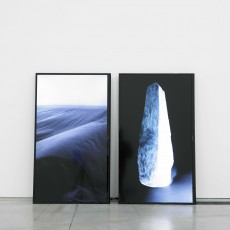
《No Future No Past》
対のビデオインスタレーション、2017年
撮影:山本糾
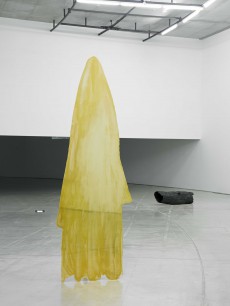
《幻》
真鍮、2500×860×600 mm、2017年
撮影:山本糾
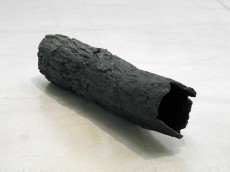
《月あかり》
粘土、約1350×350×350mm、2017年
撮影:山本糾
